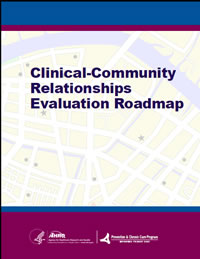The Clinical-Community Relationships Evaluation Roadmap is a resource for future research and evaluation of effective clinical-community resource relationships. The Roadmap will be of use to funders, researchers, and program evaluators interested in primary care. The resource's investigators pose priority questions and recommendations for advancing research and developing clinical-community resource measures, based on an environmental scan of measures, a targeted literature review of research, an assessment of evidence gaps, and input from an expert panel.
While the Roadmap specifically addresses clinical-community resource relationships for selected clinical preventive services, the principles and questions offered may also apply to other clinical and non-clinical services. Thus, the Roadmap also may prove applicable to those interested in effective relationships and coordination between clinics and community organizations such as schools or providers of social services.
Prepared for:
Agency for Healthcare Research and Quality
U.S. Department of Health and Human Services
5600 Fishers Lane
Rockville, MD 20857
www.ahrq.gov
Contract No. HHSA290-2010-000021
Prism Order Number: HHSA29032003T
Task Order 3
Prepared by:
Oregon Rural Practice-based Research Network (ORPRN)
Oregon Health & Science University
3181 SW Sam Jackson Park Road
Portland, OR 97239-3098
Westat
1600 Research Boulevard
Rockville, Maryland 20850-3129
Authors:
David I. Buckley, M.D., M.P.H., ORPRN
Paul McGinnis, M.P.A., ORPRN
Lyle J. Fagnan, M.D., ORPRN
Russ Mardon, Ph.D., Westat
Maurice Johnson, Jr., M.P.H., Westat
Chris Dymek, Ed.D., Westat
Contents
Executive Summary
1. Introduction and Purpose
1.1 Background
1.2 Purpose and Scope of the Evaluation Roadmap
1.3 The Importance of Context
2. Priority Questions and Recommendations
2.1 Priority Questions
2.1.1 How do the Characteristics of Primary Care Clinicians and Clinics, Patients, and Community Resources Influence the Effectiveness of Linkages for the Delivery of Clinical Preventive Services?
2.1.2 How do Characteristics of the Clinician-Patient Relationship, the Patient-Community Resource Relationship, and the Clinical-Community Resource Relationship Influence the Effectiveness of Linkages for the Delivery of Clinical Preventive Services?
2.1.3 How Does the Relative Importance and Influence of Clinics and Clinicians, Patients, and Community Resources, and their Mutual Interrelationships, Vary in Different Circumstances Or Contexts, Including the Delivery of Different Clinical Preventive Services?
2.1.4 What are the Best Methods, Strategies and Settings for Studying and Improving Clinical-Community Resource Relationships for the Delivery of Clinical Preventive Services?
2.1.5 What are the Best Measures for Evaluating the Effectiveness of Clinical- Community Resource Relationships for the Delivery of Clinical Preventive Services?
2.2 Recommendations
2.2.1 Researchers Should Use Complex Systems Approaches to Best Understand the Influence of Contextual Issues on the Effectiveness of Clinical-Community Resource Relationships for the Delivery of Clinical Preventive Services
2.2.2 Research on Clinical-Community Resource Relationships Should be Designed to Flexibly Accommodate Variability in Primary Care Clinic, Patient, and Community Resource Characteristics, Including the Use of Tailored or Semi-Tailored Interventions
2.2.3 Researchers and Program Evaluators Should Use and Develop Standard Measures of Relevant Characteristics of the Six Elements and Relationships That Influence the Effectiveness of Linkages for the Delivery of Clinical Preventive Services
2.2.4 Research Into Clinical-Community Resource Relationships for the Delivery of Clinical Preventive Services Should be Relevant and Rigorously Designed, Using Deep Qualitative Methods as Well as Formal Quantitative Study Designs
2.2.5 Research Findings Should be Reported More Thoroughly and in More Useful Formats
2.2.6 Studies Should Include Assessments of the Feasibility and Sustainability of Interventions to Improve Clinical-Community Resource Relationships for the Delivery of Clinical Preventive Services, Including Effects on Clinics, Patients and Community Resources
2.2.7 Future Research Could Consider the Conceptual Framework Developed for This Project as a Starting Point That Might be Further Refined
3. Conclusion
References
Appendixes
Appendices: Preliminary Work and Finding
Appendix A: Conceptual Framework
Appendix B.1: Evidence on Effectiveness
Appendix B.2: Use of Measures in Evaluation
Appendix C: Examples of Current State of Practice
Appendix D: Members of the CCRM Expert Panel
This document is in the public domain and may be used and reprinted with permission except those copyrighted materials that are clearly noted in the document. Further reproduction of those copyrighted materials is prohibited without the specific permission of copyright holders.
None of the investigators has any affiliations or financial involvement that conflicts with the material presented in this report.




